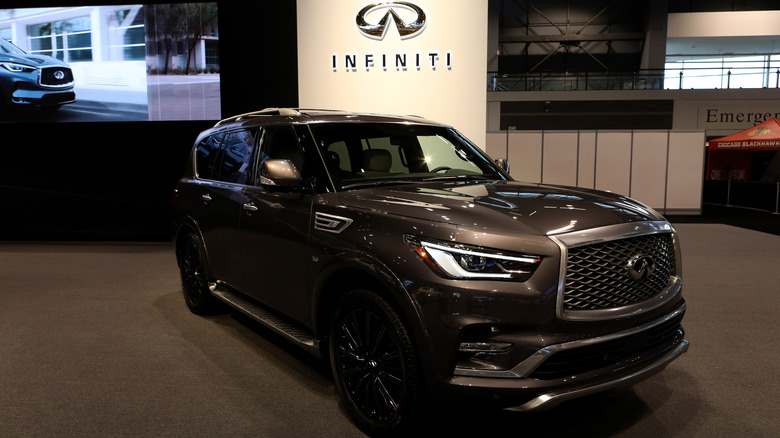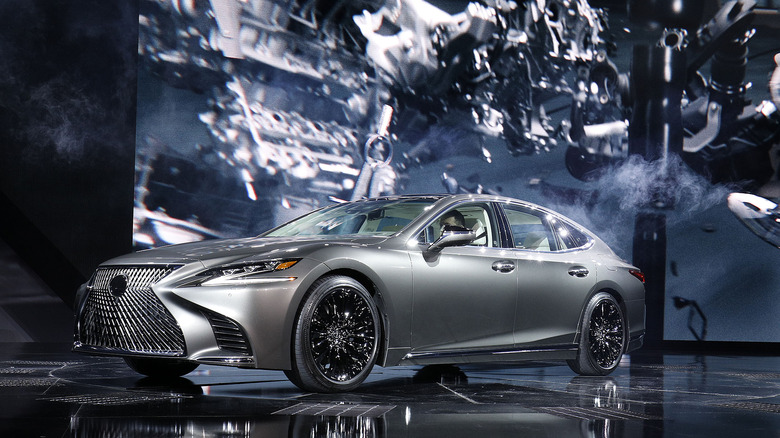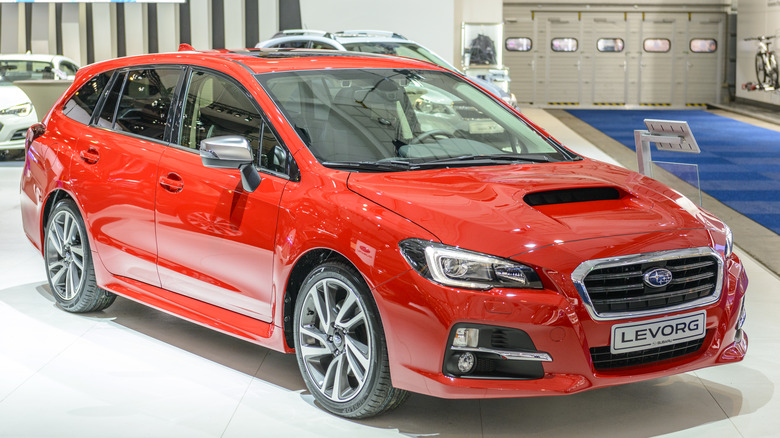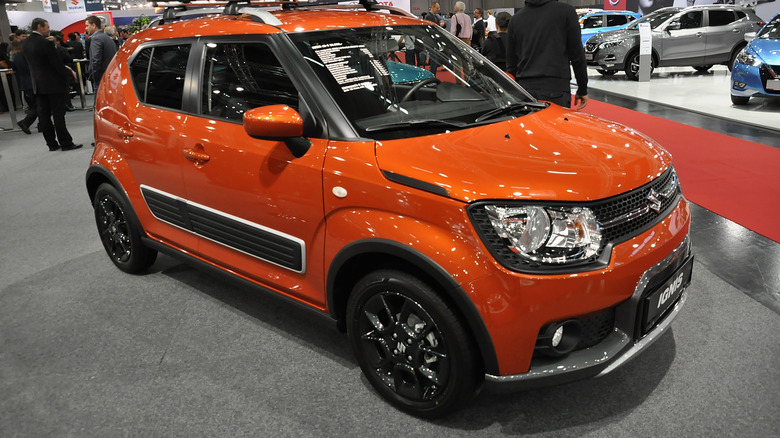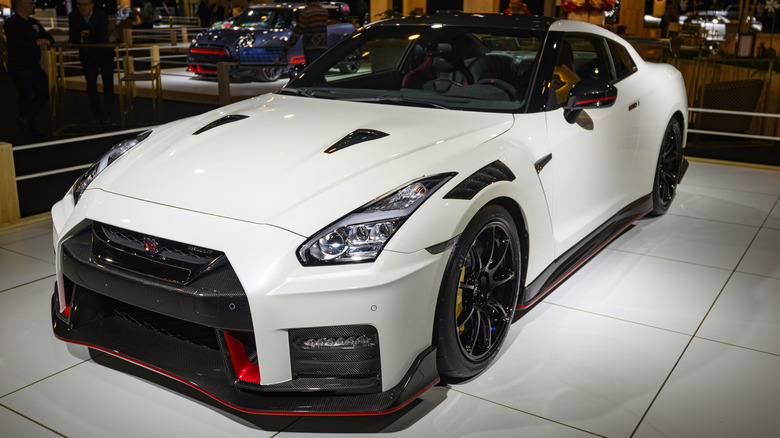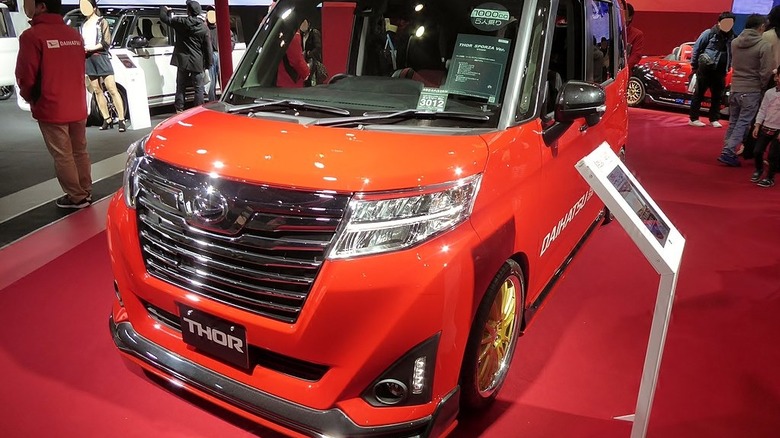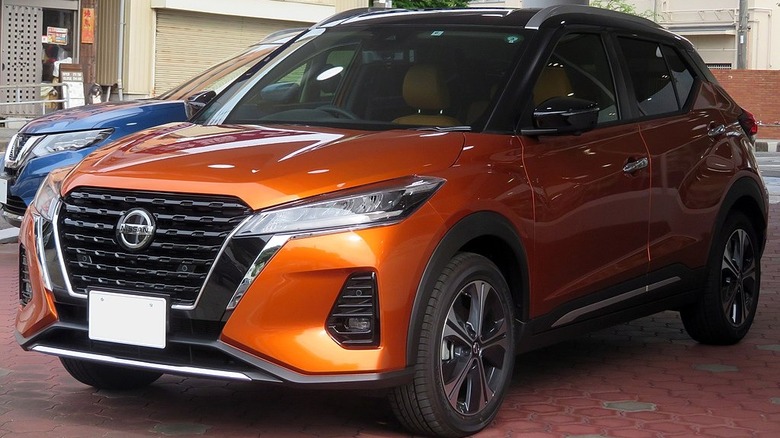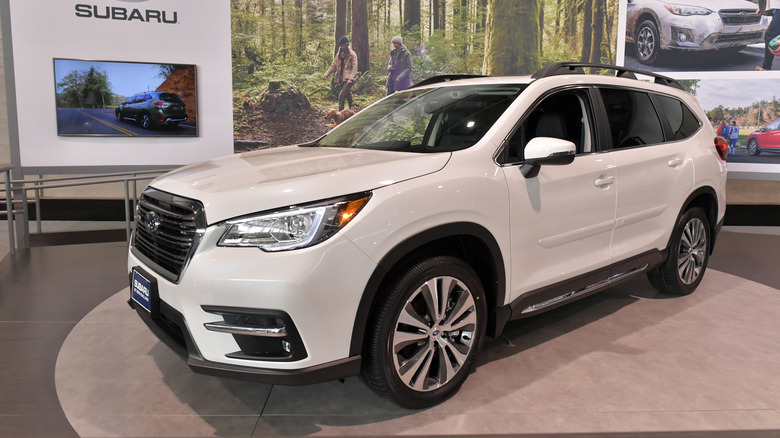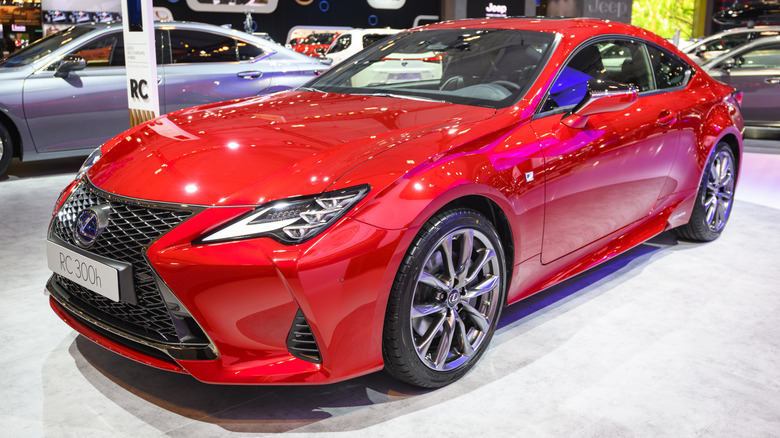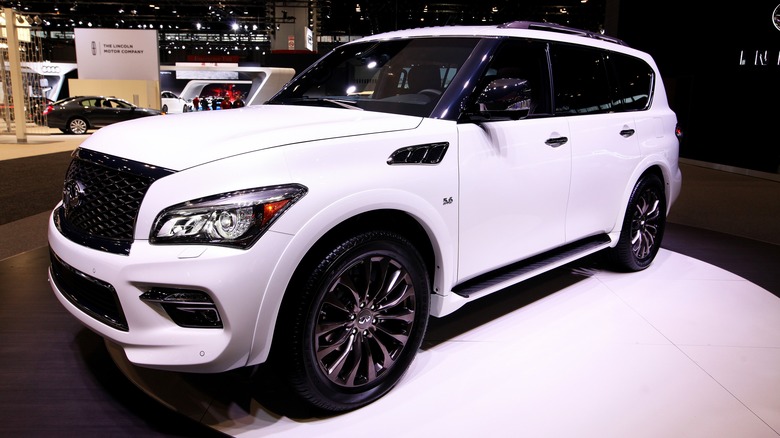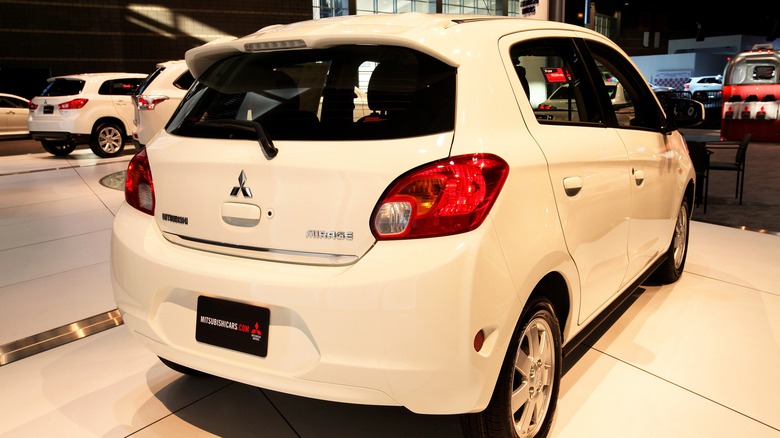10 Japanese Cars That Aren't Worth The Import Fees
Japanese cars are renowned for their affordability, durability, and reliability. While the island nation accounts for just 1.6 percent of the world's population, it is home to such auto manufacturing giants as Honda, Suzuki, Mazda, Mitsubishi, and Subaru, plus Nissan and Toyota with their luxury divisions Infiniti and Lexus. Their cars sell around the globe, and thanks to ingenuity, technological prowess, and access to raw materials, the Japanese auto industry continues to dominate.
One of the significant reasons that foreign consumers love Japanese cars is their value for money. With its high production rate and factories running around the clock, Japan makes far more cars than are required locally and has a thriving export market, with readily-available spare parts and service centers in every car-buying nation. Sometimes it doesn't make sense not to buy Japanese cars due to their low maintenance fees, competitive fuel economy, and the fact that they are less likely to leave you stranded on the side of a highway.
Despite this reputation for quality and reliability, Japan does not have a perfect record when it comes to car production. A utilitarian approach to car design can leave some of Japan's vehicles somewhat aesthetically challenged. They often lack when it comes to interior space, and some go against the grain and pose reliability and safety concerns further down the road. Here we look at the worst Japanese cars in recent years and why these models are not worth the additional price of shipping them to your doorstep.
Lexus LS Hybrid
What's not to love about a hybrid car? Well, in the case of the Lexus LS, there's quite a lot, actually. While hybrids themselves should offer you the best of both worlds, the ecological and economic benefits of an electric motor and the convenience of a fossil fuel powertrain, they have often fallen flat when it comes to aesthetics. Take the original bestselling hybrid, the second-generation Toyota Prius. Lauded by all and sundry, from politicians to movie stars and the environmentally-conscious masses, it featured an awkward, boxy profile and a snub nose that betrayed its rather brilliant performance.
It's hard to look at the Lexus LS Hybrid and not be overwhelmed by its massive front grille, which, at first glance, looks like the lower half of Darth Vader's helmet. Add to that the fact that it's made of plastic, and you have to wonder what Lexus was thinking when assigning this to its luxury sedan.
Economy-wise, the Hybrid version of the LS gives it a disappointing three-miles-per-gallon extra on average than its petrol-only equivalent, according to Car and Driver. This is especially concerning considering its vastly higher cost (over $113,000 compared to $81,000 for the gas version). With this in mind, you could do much better within this segment (such as BMW's 330e, which starts at just under $46,000), although, true to Lexus form, it drives like a dream.
Subaru Levorg
There's a big question hanging over the head of the Subaru Levorg: "Why isn't the WRX version available outside of Japan?" The Japanese have been notably reluctant to export their best rally-inspired station wagon, much to the chagrin of the world's motoring press. Instead, the rest of the world gets to play with the box the toy came in, and that metaphorical empty package is the base-level Subaru Levorg.
Unlike the WRX, which will take a thrashing around a rally circuit but offer comfort and style on the road, the Levorg falls far behind with a 147-bhp two-liter engine and no manual transmission option available. It labors to 62 miles per hour in around nine seconds and tops out at 121 miles per hour, which feels rather pedestrian, given its rallying roots. This performance is reflected in its interior, as we see a functional layout, with few frills and lots of plastic on display, and an infotainment setup that feels like a throwback from generations past.
As reported by What Car, the Subaru Levorg is expensive within its class, suffers from poor fuel economy, and feels like an inferior product at this price point, especially when compared to the station wagons from its European rivals, such as Skoda and Volkswagen, which, if import fees have already been factored into your budget, would be better options.
Suzuki Ignis
It's hard to define where the Suzuki Ignis sits in terms of car segments. It is an SUV, sure, but it is compact and has a low ground clearance of just seven inches. It is a hybrid, but unlike its punchy counterparts, it has limited power and, despite its wagon-shaped rear profile, has limited space compared to its rivals, the Nissan Juke and the Ford Puma.
The identity crisis that plagues the Suzuki Ignis carries over to its interior, where its modern external lines are juxtaposed by a basic plastic and woven fabric aesthetic, which, while it is inoffensive, isn't inspiring, either. This isn't helped by the infotainment system, which looks like an imitation iPad from yesteryear (and not one of the better ones). It should be said that although it's easy to discredit the Ignis based on looks and finish, What Car notes that it does offer an affordable solution for those with mobility issues, with wide-opening doors, a high seating position, and automatic versions available.
While Suzuki is renowned for its small, cheap runarounds, the Ignis feels like neither fish nor fowl. Lacking the power of an electric vehicle, with a painfully slow 0-62 time of around 13 seconds, and lacking the practicality of a fully-fledged SUV, the Ignis is in no-mans-land when it comes to both its design and features.
Nissan GT-R
There's nothing wrong with the GTR as it stands. As previously reported in SlashGear, it's actually a great car, so let's first take a look at the positives. This is a high-performance machine from the company that delivered the legendary Skyline, and the GT-R does not disappoint when it comes to power, with a turbocharged V6 that produces over 560 bhp and propels it to 62 miles per hour in just 2.7 seconds.
The Nissan GT-R looks and feels like the premium car that Top Gear says it is and comes with all the trimmings that you'd expect from a flagship model, including a six-speed dual-clutch transmission as standard, a full complement of onboard tech, advanced safety features, and all-wheel-drive.
So, what is the issue? When such rivals as the new Chevy Corvette exist in the domestic market or the Porsche 911 and Audi R8 on the premium German menu, there seems little reason to opt for this Nissan from across the Pacific. While there is much to love about the GT-R, with all its high specs and performance, it lacks the prestige and heritage of the aforementioned examples, and if you have $113,540 to spend on the base model or $210,740 on the high-end "Nismo" version, your money might be better spent elsewhere.
Daihatsu Thor
The Marvel Cinematic Universe delivers a new hero creation and resultant marketing flurry seemingly every other week, invading our senses on every form of media imaginable. We cannot help but wonder, then, if Daihatsu has jumped on the bandwagon, almost literally, with the 2016 release of the heroically-named Thor. As it turns out, this small MPV could not have been less aptly named. Far from conjuring the power of thunder, this minivan may be practical on some levels, but it is downright ugly and underperforms, unlike its namesake deity.
On the outside, the Thor looks like it was designed for practicality over appearance and is about as boxy as they come. It also wheezes at the pull of its 996cc engine, which produces just under 70 horsepower. Armed with this knowledge, to call this anything other than a city driver would be a mistake, and even a run in the countryside might be considered ambitious, while freeway driving should probably be discouraged.
To its credit, the Thor does come with some benefits, according to Techzle.com, including a spacious interior plus ABS, stability control, and airbags as standard, but this isn't enough to call this car a practical consideration for any form of serious driving outside of local runs.
[Featured image by Tokumeigakarinoaoshima via Wikimedia Commons | Cropped and scaled | CC BY-SA 4.0]
Nissan Kicks
As the old Shakespearean saying goes, "what's in a name?" As far as the car industry is concerned, it's quite important. Think of the classic Italian sports cars of the 1980s, such as the Testarossa and the Countach, which put drivers in the presence of greatness. The same does not apply to certain quirky little Japanese wagons, such as the Suzuki Jimny, the Nissan Juke, the Subaru Justy, and the Toyota Roomy, all of which sound more like cleaning products than car models.
Unfortunately, this theory also rings true when talking about the sprightly-named Nissan Kicks, which tries too hard to look like a quality compact SUV. However, with its 1.5-liter engine, poor ground clearance, and lack of all-wheel-drive, nobody should be fooled, as in reality, the Kicks would struggle to overtake a Greyhound bus while going flat-out.
While the Nissan Kicks has some positives, including a decent exterior finish, a touch-screen display with Apple Carplay and Android Auto, and a reasonable price tag of just over $20,000, according to The Car Connection, it has bad headlamps, unsupportive seats that do not fold flat, it comes in front-wheel-drive only, and performs poorly in safety tests. Compare it to some homegrown vehicles in this segment, such as the Chevy Trailblazer or the Jeep Renegade, and the Kicks simply comes up short.
[Featured image by Tokumeigakarinoaoshima via Wikimedia Commons | Cropped and scaled | CC BY-SA 4.0]
Subaru Ascent
There's not much off about the Ascent at first glance. It looks like one of the better-designed Japanese SUVs with prominent features that stand out in a crowded segment and a profile that retains the typical Subaru aesthetic. This is a much-admired family vehicle with space for up to eight people, with a range of up to 27 miles per gallon. It has all the features you'd expect of an SUV within this price range, including a top-notch 11.6-inch infotainment system and many safety features as standard.
On paper, the Subaru Ascent looks like a well-priced SUV from a respected manufacturer. One with a history of making hardy vehicles that excel on grueling rally circuits around the world, no less. You'd be forgiven for thinking that this is a competitive car within its segment and one that will not only withstand many years of trouble-free driving but that can be put through its paces on rough terrain should the need arise. That is, until you roll it off the forecourt, and certain issues start to rear their ugly faces.
Alas, the Ascent has descended among the ranking of market reviewers such as Consumerreports.org, having been persistently dogged by reliability problems in subsequent versions since 2019 affecting its brakes, transmission, electronics, and climate control. Other issues include a recurring fuel pump problem, a weak windshield, and other bugs in the system.
Lexus RC
Once again, the brand that has often been compared to Mercedes falls short of expectations with its recent luxury sports coupe offering. There's first the point of its questionable aesthetics, with the same front grille as the Lexus LS that looks like something better suited to filtering krill on a large undersea mammal.
Performance-wise, while its lines are undoubtedly sporty, the RC fails to live up to its looks. This luxury sports coupe is heavy on luxury but light on sports, and this is a shame. As Car and Driver reports, even the top-of-the-range RC350 fails to deliver on power with its all-wheel-drive, six-speed configuration. While it is undoubtedly beautifully upholstered and finished on the inside, the RC is not ideal for the heavier set in terms of rear-seat comfort. Add to this an unremarkable fuel economy, and other brands shine brighter within this segment.
When compared to its superb German rivals, the BMW 4-Series and the Audi A5, you get much less for your money with the Lexus RC. This doesn't make it a bad car by any stretch of the imagination, but on balance, you might look to Europe when considering a comprehensively-packaged sports coupe.
Infiniti QX80
Just as Toyota has Lexus, Nissan has Infiniti as the luxury branch of its business, and the Infiniti QX80 is its flagship SUV. While its exterior has barely changed in the last 10 years, it doesn't look dated and stands up well next to the competition. However, this cannot be said for its interior, and while fans of old luxury British saloons from marques like Rolls-Royce, Bentley, and Jaguar might appreciate the cabin of the Infiniti QX80, with its walnut paneling and too much chrome, it is not particularly in keeping with modern tastes.
You tend to get what you pay for in the car industry, but this isn't necessarily true of the QX80. As compared to its competitors like the Cadillac Escalade ($80,000) and the Mercedes GLS-Class ($83,000), the QX80 has a lower price of $77,700, which sounds reasonable, but as Car and Driver reports, it is based on the much cheaper Nissan Armada, which is by no means a high-end vehicle.
This feels like a disappointing solution for budding Infiniti customers expecting a premium vehicle but, in fact, are simply paying a premium for a few bells and whistles on a mechanically identical machine to the Armada. So, while the Infiniti QX80 certainly performs well and looks great on the street, it will never quite compete with the pedigree and quality of its American and European rivals.
Mitsubishi Mirage
The Mirage is not Mitsubishi's finest. The company that delivered the hardy Shogun 4x4 and the rally-wining Lancer Evo has a wide range of vehicles in its catalog, and the Mirage is its entry into the affordable subcompact segment. It first entered the market in 1978 and stayed in production for an impressive 25 years before being discontinued and reemerging in 2012 as a replacement for its Colt hatchback.
It's not all bad news for the Mirage, as its latest model has excellent fuel economy, is roomy for a small hatchback, and is available at a very reasonable base price. However, according to national statistics, the Mirage is the most dangerous car in the United States, with a death rate of 10.2 people per billion miles driven according to Carscoops (around four times the national average). It is also dangerously slow and certainly not worth the (admittedly very small) price tag. Add to this a cheap-looking plastic interior, unresponsive handling, and a 78-horsepower engine that lacks any character whatsoever.
It would be hard to believe that Mitsubishi wouldn't have addressed the safety issues at the manufacturing level before reissuing the latest model. But reputations have to be earned, and for a car with such a long and distinguished pedigree as the brand's bestselling compact model, Mitsubishi's Mirage has some making up to do.
